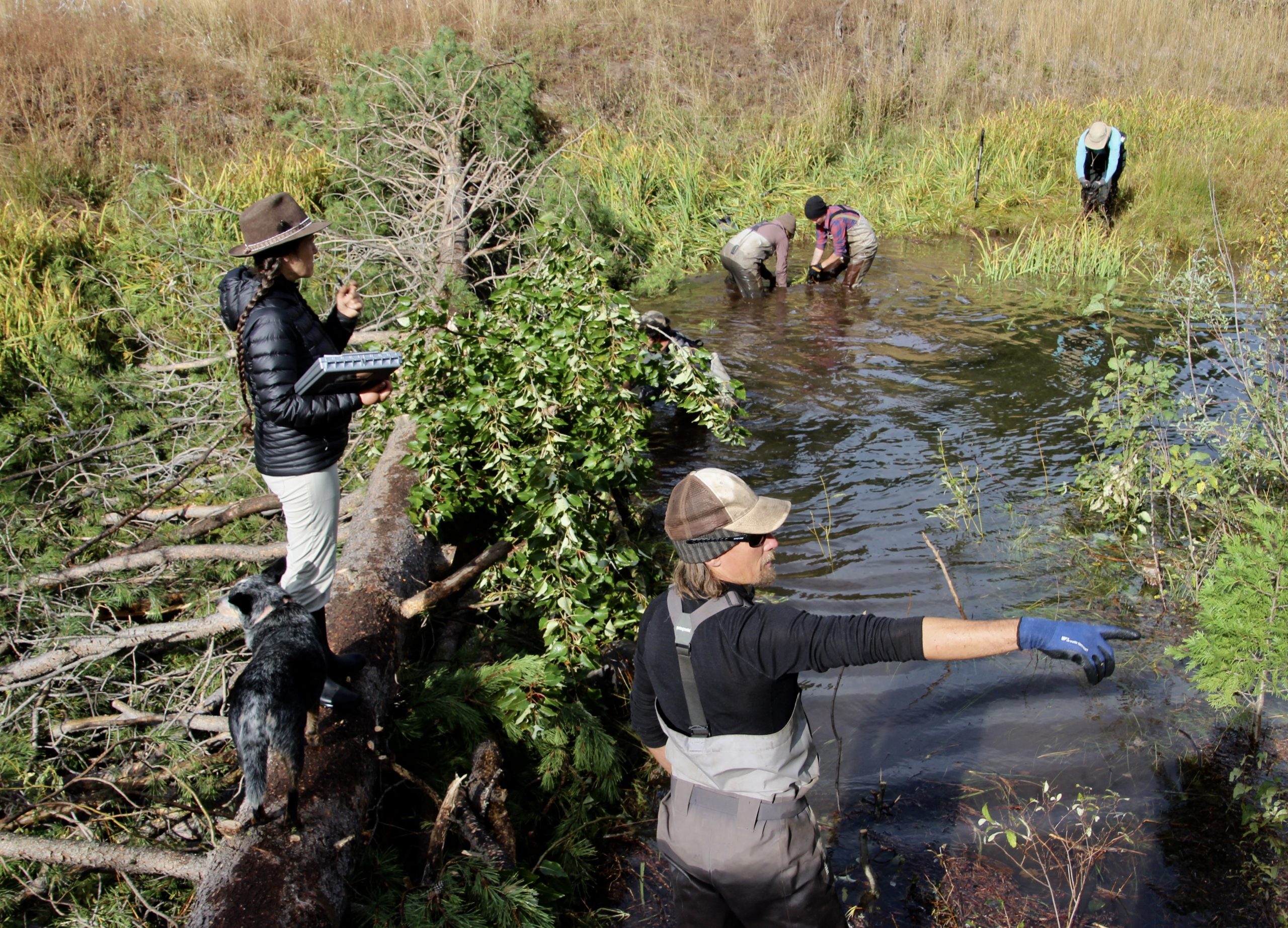
Last fall, the Maidu Summit Consortium, a nonprofit composed of nine Mountain Maidu tribal member groups, installed 73 BDAs—beaver dam analogs—in Yellow Creek, a tributary to the North Fork Feather River and a state-listed heritage trout stream. Swift Water Design and U.S. Fish and Wildlife Service designed the structures, and Mountain Maidu tribal youth worked with Swift Water to build them. The idea behind the structures, which mimic beaver dams, is to slow erosion, catch sediment, and build up the river bottom to reverse the incised channel—without importing soil and other materials or emitting carbon from heavy, diesel-powered equipment.
“Before this project, PG&E had done some pond and plug projects to restore the meadow,” says Trina Cunningham, executive director of the Consortium. “We wanted to try to restore habitat more naturally in a less invasive way.”
In 2019, the 2,300-acre Humbug Valley, known as Tásmam Koyóm to the Maidu, was returned to the tribe as part of PG&E’s land divestiture resulting from their bankruptcy settlement. The tribe has been working to restore meadow and riparian ecosystems ever since. “We want to see more fish diversity, a more diverse ecosystem,” says Cunningham. “We miss the beaver, porcupine, and other animals that are important to the ecosystem. Compared to pond and plug, if you have beaver doing the work they can restore meadow systems, catch sediment, address head cuts, and stop incision just as good if not better than equipment.”
Pond and plug involves excavating local material to make “plugs” to fill channels to their historic meadow floodplain elevation. The excavated sites fill with water from the stream and groundwater, resulting in “ponds.”
Kevin Swift, founder of Swift Water Design, led the team installing the BDAs in the first of what will be several phases. “It’s process-based restoration rather than using diesel and rock and insisting on imposing a form on the river,” he says. “Instead, we use the power the stream brings us and introduce materials that give the stream something to work with. Those structures drive channel evolution and add roughness and complexity—with a small bit of human nudging you can begin to correct structurally starved streams.”
The BDAs are installed strategically, not randomly. “In any given stream, there will be interesting points where evolution or recovery is most likely to occur, and where we might adopt and build three or more structures that interact and support each other there.”
Swift’s BDAs replicate beaver dams as closely as possible. “You build low with a heavy, wide base, a low rise on the front and back, just like a beaver dam and you just sort of needlefelt together all of the materials you find around, making a kind of lasagna.” When the BDA is finished, says Swift, “you should have a big messy pile of mud and sticks like a beaver dam holding water. At base flow you should have water going over the top.” In certain situations, if willow is growing nearby—and “not being used by willow flycatchers”—he’ll add it to the BDA as he builds it. “Those willows will root and sprout and help perennialize the structure.”
Sophia Williams, a young Mountain Maidu tribal member, says the experience of building the BDAs was rewarding and fun; she hopes to make more (Williams is pictured here with other Maidu youth participants). “We found several willow bushes a couple miles from our dam location. Once all the willow was woven we then filled in all the gaps with [more] willow and packed it with mud. Just after an hour of the analogs being built, the stream began to rise.”
Swift doesn’t expect the BDAs to stay exactly as built but instead to evolve and change over time—and even to blow out on rare occasion—just like real beaver dams. “If the stream doesn’t like something, you’ll get quite a critique,” he says. His main goal for the BDAs on Yellow Creek is to raise the groundwater table and reconnect the main stem with its side channels (great habitat for fish) and its floodplain. “I want to get water up and out on the floodplain every year—that’s where the magic is, that’s the life of the river.”
Although the California Department of Fish and Wildlife (CDFW) will not allow people to bring beavers back to the site, the BDAs could attract the furry, long-toothed engineers, say Swift and other consortium members, who would love to see them return: there are beaver present in nearby tributaries, and cattle grazing has been discontinued since the Maidu took over land management, so there is now plenty of willow and other vegetation for beaver.
Kate Lundquist, WATER Institute director with the Occidental Arts & Ecology Center (OAEC), who got involved in the BDA work through a grant from CDFW and developed a planning strategy for recruiting beaver, says, “We need to keep the ‘B’ in ‘BDAs.’ We want people to be doing instream structures, but we want to make sure people don’t forget the beaver. If you are building them in areas where you have beaver, they will manage and maintain the structures. Instead of being on the hook for maintenance, let the beavers do the work.”
Lundquist says that while some state officials have expressed doubt that beaver were native to the Sierra, she and OAEC co-director Brock Dolman have combed through historic accounts and found plenty of evidence of their presence, including a remnant dam carbon-dated to 1,270 years ago and an account from an older resident of the area who remembers a giant beaver dam and the best fishing of his life on a Yellow Creek tributary. “Tásmam Koyóm is ripe for beaver again,” says Lundquist.
Top Photo: Kevin Swift and his crew designed and installed BDAs on upper Yellow Creek. Photo: Brock Dolman, OAEC.
Prior Estuary News Stories
Beavers Make Good Neighbors, March 2021
Other Links
Low Tech Process Based Restoration for Riverscapes manual
Beaver Recruitment Strategy for Tásmam Koyóm
The Beaver Restoration GuidebookBeaver in California: Creating a Culture of Stewardship